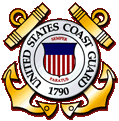



![]()


![]()

YEAR BUILT: 1923
BUILT AT: Bath (ME)
APPROPRIATION: ?
BUILDER: Bath Iron Works
CONTRACT PRICE: $200,000
SISTER VESSELS: LV 107,108,l09,110,111
DESIGN: Steam screw; steel hull, steel pilot house and deck houses, 2 masts with lantern galleries, smokestack amidships
LENGTH: 132'4"; (loa); BEAM: 30'0"; DRAFT: 14'7"; TONNAGE: 775 displ
PROPULSION: Steam - compound reciprocating engine, 400 IEP; 2 oil fired Scotch marine boilers, 120 psi; 4 bladed propeller; max speed 9 knots
ILLUMINATING APPARATUS: 375 mm electric lens lantern at each masthead
FOG SIGNAL: 12" steam chime whistle, submarine bell, submarine oscillator, hand operated bell
CONSTRUCTION NOTES - MODIFICATIONS -
EQUIPMENT CHANGES & IMPROVEMENTS: LV 106-
1923: Equipped with radio, radiobeacon, submarine oscillator, submarine bell-
1931: Submarine oscillator discontinued-
1933: Re-powered; GM diesel 4SOHP, 4'9"dia propeller, max speed 7 knots-
1935: Fog signal changed to air whistle-
1935: Supplied with new cage antenna of improved design to improve field strengh
and coverage of radiobeacon-
1961: USCG lists vessel with duplex 375mm lens lantern 16,OOOcp each lamp on
foremast; F2T air diaphone; other characteristics as above-
Radio and visual call sign NNGY (1940-1961)
STATION ASSIGNMENTS: LV 106 / WAL 528
1923-1931: Nantucket Shoals (MA)
1931-1934: Relief (MA)

A view of her Spar deck.

Life Boat Drill 1934
1934-1936: Nantucket Shoals (MA)
1936-1942: Relief (MA)
1942-1945: Examination Vessel, WWII

Damage caused
to LV-106 after the USS PCE/R/851 collided with her in 1949.
1945-1967: Relief (MA)
(1942-1945: During WWII stationed at Woods Hole MA and used as an examination vessel, no armament provided)
HISTORICAL NOTES: LV 106 / WAL 528-
1923: Aug 20, placed on Nantucket Shoals station-
1924: Oct 29, for test and evaluation, radio fog signal (i.e. radiobeacon) was
operated 24 hours/day on the first 15 minutes of each hour for 6 months. (At
this time, radiobeacons normally transmitted only during poor visibility)-
1928: Jan 25, during gale, dragged 4 mi SE of station; regained station same day
when weather moderated-
1934: May 16, placed on Nantucket station on the day after LV 117 had been
rammed and sunk on that station-
1934: Sep 12, low power proximity warning radiobeacon placed in service for
test; providing a variable tone signal (warble), and operating 1 minute out of
every 3 during the test; vessels reported receiving the signal at 10-15 mi.
range with noticeable increase in loudness as the lightship was approached
More notes:
RETIRED FROM LIGHTSHIP DUTY: 1967; AGE: 44
SUBSEQUENT DISPOSITION: Decommissioned Oct 17, 1967, On Jun 4, 1968, transferred to Agency for International Development (AID) for further transfer to Surinam; still in use in Surinam as of 1973
COMMANDING OFFICERS: LV 106 / WAL 528
1923-1931: David B Studley, Master
1923-1925: Lars 0. Johnson, 1st Mate
1925-1926: Thomas M O'Brien, 1st Mate
1926-?: Warren W. Eliot, 1st Mate
1936-1939: Edward Andreason, Mate
1939-?: Ernest B Waters, Mate
1961: WO R A Jones, OIC
1966-1967: CWO Edward T Kassick, CO
1967: CWO David N Russell, CO
![]() Back to Nantucket Lightship Station
history
Back to Nantucket Lightship Station
history
Copyright © 2003 United States Coast Guard Lightship Sailors Association
INC. All rights reserved.
Copyrights also protected by the
Digital Millennium Copyright Act of
1998
Revised: 10/23/06.